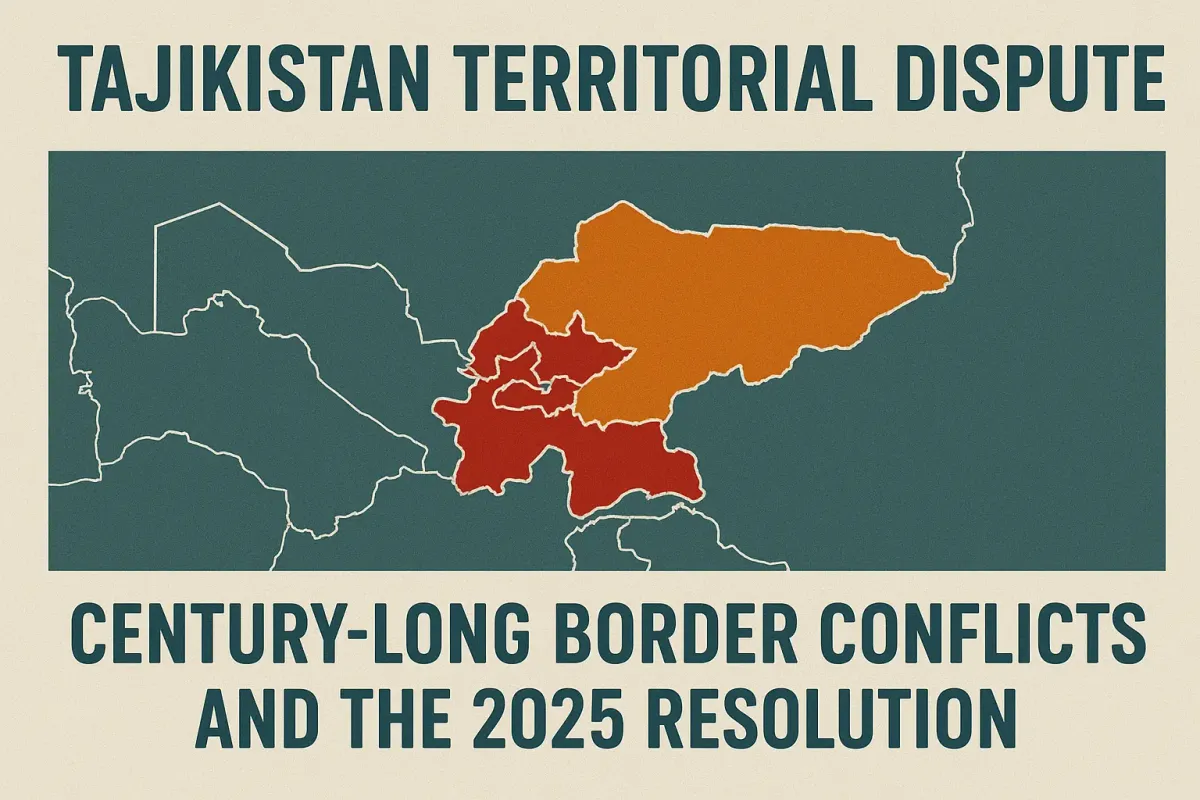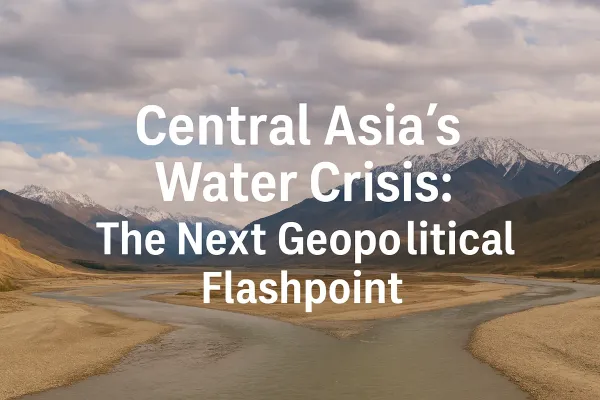Tajikistan–Kyrgyzstan Border Dispute: Century-Long Tensions and the 2025 Peace Resolution
The Tajikistan territorial dispute finally ended March 13, 2025—after 101 years, multiple wars, and 100+ deaths. That 972-kilometer line with Kyrgyzstan turned into a war zone in 2022, forcing 100,000 to flee. Here's how two presidents ended Central Asia's longest border nightmare.

The Tajikistan territorial dispute finally ended on March 13, 2025 - but getting there took 101 years, multiple wars, and over 100 deaths. Ever since the Soviet Union fell apart in 1991, Central Asia territorial disputes with Kyrgyzstan, China, Uzbekistan, and Afghanistan have kept Central Asia on edge. That 972-kilometer line between Tajikistan and Kyrgyzstan? It turned into a war zone in September 2022, killing scores of people and forcing 100,000 to run for their lives. When Presidents Sadyr Japarov and Emomali Rahmon signed their treaty in Bishkek, they weren't just drawing lines on a map - they were ending Central Asia's longest-running border nightmare.
Soviet Legacy Behind Tajikistan–Kyrgyzstan Border Dispute
Here's how the Tajikistan territorial dispute started: Stalin's bureaucrats in the 1920s carved up Central Asia like they were slicing a pie, completely ignoring where people actually lived or where natural borders made sense. They took the Fergana Valley - some of the best farmland in the region - and chopped it up between Uzbekistan, Kyrgyzstan, and Tajikistan. Nobody cared back then because it was all one big Soviet family anyway. People crossed those lines every day for work, visiting relatives, whatever.
Then 1991 hit. The USSR collapsed, and suddenly those random administrative lines became real international borders with soldiers, checkpoints, and guns. Six separate enclaves got trapped on the wrong side of new boundaries, and the mountains made it impossible to figure out where one country ended and another began. Both sides started digging up old Soviet maps - different versions, of course - to prove their claims. What started as paperwork fights turned into shootouts by the mid-1990s. The Uzbekistan border dispute played out almost identically, with Soviet agricultural policies trampling on how nomads actually lived, creating grudges that exploded after independence.
Tajikistan–Kyrgyzstan Clashes Turn Deadly (2014–2022)
Kyrgyzstan border trouble escalated from throwing rocks to full military combat after independence. Deadly clashes broke out in 2014, 2021, and 2022 - each one worse than the last, with neighbours who'd lived together peacefully for generations now shooting at each other.
September 2022 changed everything. A six-day war near Batken killed 100 people - 59 Kyrgyz, 41 Tajik - and wounded nearly 300 more. Over 100,000 Kyrgyz grabbed their kids and ran while both armies brought out rocket launchers and drones, blowing up schools and hospitals. It was the bloodiest fighting between two Central Asian countries since the Soviet breakup.
That disaster actually shocked everyone into talking. By late 2022, secret diplomatic meetings started up again. All through 2023 and 2024, both sides held 45 protocol sessions and created 25 legal working groups to hash things out. On December 4, 2024, they announced a tentative deal that gave people hope peace might actually stick this time.
March 2025 Treaty Ends the Tajikistan Territorial Dispute
March 13, 2025 rewrote the history books for the Tajikistan territorial dispute. Japarov and Rahmon signed a comprehensive treaty in Bishkek that mapped out every kilometre of that 972-kilometre border through equal land trades. They solved the really messy stuff too - Tajikistan's Vorukh exclave stuck inside Kyrgyzstan, and Kyrgyzstan's Dostuk village. "The border issue between Kyrgyzstan and Tajikistan, which had remained unresolved for 101 years since 1924, has finally been settled," Japarov told reporters, then added something bold: "From this moment on, eternal peace has been established in Central Asia".
The treaty banned drones and heavy weapons near the border and set up joint committees to manage water resources - the kind of stuff that prevents future blowups. Kyrgyzstan handed over Dostuk (which literally means "friendship" in Kyrgyz) to connect Vorukh back to mainland Tajikistan, promising people being relocated brand new houses. The whole thing stayed secret until Kyrgyzstan's security boss Kamchybek Tashiyev briefed parliament on February 27, explaining why both countries had to give ground: "the border issue should never be resolved in favour of only one side".
Results came quick. Border crossings at Kairagach and Kyzyl-Bel that'd been shut for four years opened up the same day. Roads, trains, flights - everything that stopped after the 2022 war started running again, with both countries promising to hit $500 million in trade.
Khujand Declaration Extends Peace Across Central Asia Borders
Two weeks later, the Uzbekistan border dispute got resolved too. On March 31, 2025, the presidents of Kyrgyzstan, Tajikistan, and Uzbekistan met in Tajikistan's old city of Khujand and declared all territorial fights over. The Khujand Declaration created a three-way border junction after almost 20 years of talking and six rounds of government meetings.
Everyone committed to speeding up the CASA-1000 power line and other big regional projects. Uzbekistan's behind-the-scenes work made the whole thing possible - Tashkent got Rahmon and Japarov talking again after years of the two refusing to even shake hands. The deal sorted out 200 disputed kilometres in the Fergana Valley between Uzbekistan and Kyrgyzstan through land swaps, with Kyrgyzstan keeping about 100 hectares including key roads.
Central Asia Border Disputes: Uzbekistan, Turkmenistan & Kazakhstan
The Tajikistan territorial dispute mirrors what happened across the region, though each country's situation looked different. The Uzbekistan territorial dispute focused on farmland and water points in the crowded Fergana Valley - politically tricky even though the land's flat and easier to measure than Tajikistan's mountains. Different Soviet maps and arbitrary valley divisions created ethnic beef between Kyrgyz, Tajiks, and Uzbeks that lasted decades.
The Kazakhstan territorial dispute got settled earlier through one-on-one talks, helped by massive stretches of steppe and fewer people living near borders. The Turkmenistan border dispute stays quietest because desert frontiers and Turkmenistan keeping to itself mean less pressure compared to the rest of the region.
Tajikistan–China Border Settlement: 14 Years of Negotiation
Tajikistan's territorial dispute with China dragged on even longer in some ways. A 2002 deal had Tajikistan give up 1,122 square kilometres of remote Pamir Mountains while China dropped claims to 28,000 square kilometres of Tajik land. The lopsided swap reflected both old Qing Dynasty claims and modern reality about China's weight in the region.
The Tajik government sat on it until January 2016 before letting parliament vote, scared of backlash like what hit Kyrgyzstan in 1999 when giving China land triggered huge protests and people tried impeaching President Akayev. When Tajikistan's parliament finally approved it, officials spun it as locking down Chinese investment and border security. Critics said the government sold out ancestral land for Beijing's good graces, though it did eliminate one potential conflict with Central Asia's biggest power.
Tajikistan–Afghanistan Border Crisis Still Unresolved
Unlike the wins with Kyrgyzstan and China, Tajikistan's 1,300-kilometre Afghan border stays a live crisis. This isn't about where to draw lines - it's about ideology clashing with Taliban rule, militants sneaking across, and humanitarian disasters that no treaty fixes. Tajikistan's refused to recognize the Taliban since August 2021, backing Afghan opposition groups instead and constantly warning about extremists crossing over.
Ethnic connections make security even messier. About 30 percent of Afghans are ethnic Tajik, creating cultural bonds alongside political tension. Several big-name anti-Taliban Afghan leaders live in Tajikistan now, which pisses off Kabul and raises fears about revenge attacks. Fighting between Tajik border guards and Taliban fighters broke out as recently as October 2025, proving how unstable it still is.
The Collective Security Treaty Organization (CSTO) - Russia, Kazakhstan, Armenia, Kyrgyzstan, Belarus, and Tajikistan - sent weapons and gear to the Tajik-Afghan border to stop terrorists getting through. Everyone recognizes Afghanistan's chaos threatens the whole region, not just Tajikistan. Being next door to the world's biggest opium producer means Tajikistan deals with massive drug trafficking through mountain passes that are hard to patrol.
Central Asia Water Disputes After the Tajikistan Border Resolution
Settling borders didn't solve water fights. Fergana Valley farms need water that's getting scarcer, making control over pipes and channels strategically huge. That April 2021 conflict between Tajikistan and Kyrgyzstan? Started over the Golovnoi water point, showing how fast resource fights turn violent even when borders are marked.
The 2025 deal included rules for managing water together, acknowledging peace needs more than just boundary lines. But climate change hitting glacier-fed rivers plus everyone wanting to develop differently makes fair sharing really hard.
**Read our full analysis: Central Asian Water Diplomacy: Rising Tensions and the Fight for Regional Stability.
What’s Next for Central Asia After the Tajikistan Border Deal
Tajikistan border resolution 2025 marks a major turning point for Central Asian stability. By ending 101 years of contested boundaries through sustained diplomatic compromise, Tajikistan and neighbours showed even deeply stuck post-Soviet territorial conflicts can get solved through mediation when political will lines up with wanting regional stability. The deals open economic doors, cut military budgets, and create systems for managing shared resources that go beyond just drawing border lines.
Frequently Asked Questions
When was the Tajikistan-Kyrgyzstan border dispute resolved?
The Tajikistan territorial dispute with Kyrgyzstan officially ended March 13, 2025 when Presidents Japarov and Rahmon signed a treaty in Bishkek mapping the entire 972-kilometer border.
What caused the Tajikistan territorial dispute?
The Tajikistan territorial dispute started from Soviet-era boundaries drawn arbitrarily in the 1920s without considering ethnic communities, geography, or resources. These Soviet lines became contested international borders when the USSR collapsed in 1991, creating immediate territorial tensions.
Does Tajikistan still have border conflicts?
While the Tajikistan territorial dispute with Kyrgyzstan and China plus the Uzbekistan border dispute are resolved, Tajikistan's 1,300-kilometer Afghanistan border remains a serious security problem with armed clashes as recent as October 2025.
What is the Vorukh exclave?
Vorukh is Tajik territory completely surrounded by Kyrgyzstan that became a major flashpoint in the Tajikistan territorial dispute until the 2025 deal provided connections through land trades, including Kyrgyzstan giving up Dostuk village to allow access.
How deadly was the 2022 Tajikistan-Kyrgyzstan conflict?
The September 2022 clashes in the Tajikistan territorial dispute killed over 100 people (59 Kyrgyz, 41 Tajik), injured nearly 300, and forced 100,000+ to flee as both sides used heavy weapons.
Related Articles:
- Water Scarcity in the Middle East: The Silent Crisis Reshaping Power and Politics (2025 Update)
- From Allies to Adversaries: How the Taliban–Pakistan Relationship Broke Down and What It Means for South Asia
- The Indo-Pacific in 2025: Power, Pragmatism, and the Search for Balance





